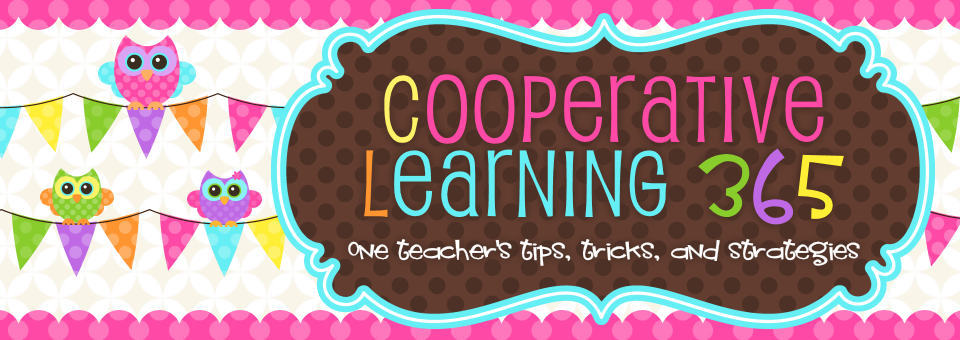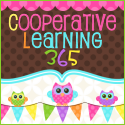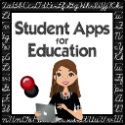I came across The Marshmallow Challenge. This will be a great teambuilding activity that can also be tied into Science. Each team of students are given 20 pieces of uncooked spaghetti, 1 yard of tape, 1 yard of string, and 1 marshmallow. They have 18 minutes to construct a structure using all the supplies. The big rule is that the marshmallow has to be on top!
This is one activity that I'm looking forward to trying out in my classroom!
Wednesday, February 29, 2012
Tuesday, February 28, 2012
Who Doesn't Love a Good Sale?
This year we are blessed to have an extra day on the February calendar. It only happens every four years so this is a time to celebrate, and what better way to celebrate than a great sale! Teachers Pay Teachers is having a 10% off sale. All you need to do is enter the code L2P9Y when you checkout on February 29.
On top of this I am offering 20% off on all my products in my Teachers Pay Teachers store! Don't miss out on a great sale, I know I will be there!
On top of this I am offering 20% off on all my products in my Teachers Pay Teachers store! Don't miss out on a great sale, I know I will be there!

Thursday, February 23, 2012
PINteresting Teacher Blogs!
Remember the post I had yesterday, without much information? I have the information, and it is HUGE as promised! It's a giveaway, and not just any giveaway. There is not just one but two $200 Amazon gift cards up for grabs! Here is how it works:
1. Go to Charity Preston's Pinteresting Teacher Blogs Pinterest Board.
2. You will need to create your own Pinteresting Teacher Blogs Board, then repin each of the 13 pins on Charity's board.
3. Once you are finished pinning, click on the Pinteresting Teacher Blogs button (it looks like the one above) to be taken to the official entry form.
It's very easy. Simply follow these three steps and you have a chance to win one of two $200 Amazon gift cards! Contest ends Sunday February 26 at 10 p.m. ET, so don't wait!
Good Luck!

Wednesday, February 22, 2012
Tuesday, February 21, 2012
Go Green with Number Draw
With Number Draw, students can practice a variety of concepts without the paper/pencil! Concepts may include sums, differences, products, odd and even numbers, and also prime and composite numbers.
Variations
Variations
- Students use only use one hand, where the largest product would be 25.
- Students use both hands, where the largest product would be 100.
- Find the sum.
- Find the difference.
- Is the sum, difference, or product even or odd?
- Is the sum, difference, or product prime or composite?

Sunday, February 19, 2012
I have... Who has.. Games
I have been creating a number of I have...Who has... games! First, my students L-O-V-E playing these games. I don't even have to finish my sentence when telling them we are going to play, and I hear the yays spread throughout the room. The instant I whip out these cards, I feel like a superstar! Second, playing I have...Who has... is great for differentiating instruction. Learning is being differentiated and students don't even know.
Each set contains a set of 24 game cards, directions for how to play I have...Who has..., and an answer key to keep track and help students along, if needed.
These I have...Who has... games are so much fun, I felt they warranted their own page.
Do you need a specific set of I have...Who has... game cards? I would love to hear what you are looking for and might be able to point you in the right direction!

Wednesday, February 15, 2012
Synchronized Write 'n' Pass
Here is a twist to the traditional Write 'n' Pass. Instead of limiting engagement to partners, teams are simultaneously engaged with given topics. There are a few variations to this activity. You can simply have students write a specific prompt on top of a piece of paper or marker board for which they pass. You can also use different worksheets.
For example, my class just finished up with Geometry. I wanted them to review perimeter, area, and characteristics of 3 and 2 dimensional figures. I gave each student a review sheet (worksheet). Student one started with the perimeter review, student two with area, student three started with characteristics of 2-D figures, and student four started with 3-D figures. Students have the choice in the problem that they do, they do not have to go in order as they are on the paper. This allows for differentiation. Students are able to complete the ones that they can do, but still have the opportunity to see the other problems that their teammates have completed.
For example, my class just finished up with Geometry. I wanted them to review perimeter, area, and characteristics of 3 and 2 dimensional figures. I gave each student a review sheet (worksheet). Student one started with the perimeter review, student two with area, student three started with characteristics of 2-D figures, and student four started with 3-D figures. Students have the choice in the problem that they do, they do not have to go in order as they are on the paper. This allows for differentiation. Students are able to complete the ones that they can do, but still have the opportunity to see the other problems that their teammates have completed.
Have you used something similar in your classroom? What other ways could this be used? I would love to hear your ideas!

Monday, February 13, 2012
You Know You're a Teacher When...
You have nightmares that you forgot to take down all the anchor charts in your room on the day of state testing and get caught!
Oh the truth in this! I think this is becoming a recurring dream for me for weeks leading up to our MAP test.
Jeannie at Kindergarten Lifestyle is having a You Know You are a Teacher When.... linky. What a great idea!! These are so funny and SO true!
Oh the truth in this! I think this is becoming a recurring dream for me for weeks leading up to our MAP test.
Jeannie at Kindergarten Lifestyle is having a You Know You are a Teacher When.... linky. What a great idea!! These are so funny and SO true!

Friday, February 10, 2012
Problem Solving At Its Finest
 Recently I decided that I needed to add a bit more problem solving into my student's daily routine. I have known about Laura Candler's Daily Math Puzzler Program and thought I would give it a try.
Recently I decided that I needed to add a bit more problem solving into my student's daily routine. I have known about Laura Candler's Daily Math Puzzler Program and thought I would give it a try. Laura has four available levels. I am a fourth grade teacher, and I knew my students’ ability varied, so I needed to determine what level(s) I needed. After six months with my students, I know that they are fairly good at problem solving. I was confident that I could start my students on Level B, but I wanted to track their progress. For this reason, I went ahead and gave them a problem solving pretest. I used Laura’s free Problem Solving Assessment, and tested them on Level A,B, and C. Using the tips for analyzing the students work outlined in the pack, I grouped my students accordingly. The results of the pretest placed approximately two-thirds of my students in Level B and the rest were in Level C.
I have found that my students respond best to short periodic practice, so I wanted to keep this problem solving practice short and to the point. I cut out each problem so students only have one problem to look at. Even though students are on different levels, they do not make this connection because once they have completed their problem, I check their work giving them immediate feedback on their own problem. Once I have checked and provided instruction, if needed, they take their problem and glue it into their Composition notebook that we call “Brain Book”. Our Brain Books go home daily for parents to look at and sign, so parents are also seeing how students are doing on their problem solving.
As a result of using Laura Candler’s Daily Math Puzzlers, I have seen improvement in my students’ ability to problem solve. What has always been a chore and full of moans and groans, has changed into an exciting part of our day. Their excitement is due to their ability to feel successful, the quick process, and the immediate feedback.
Daily Math Puzzlers contain an amazing amount of resources in all available levels.
- Tips from real teachers that have implemented the program
- Letter to parents explaining the program
- Cooperative learning activities are outlined with directions
- Progress charts
- Rubric
- Enrichment activities and games
- Practicing calculator skills
- Checklist for students to use while solving problems
- Math problem template for creating additional problems
- Encourages students to show their work and explain their thinking
- The eBook is convenient for printing and pulling up examples onto the Smart Board
If you are looking for a way to add more problem solving to your day, want to excite your students, and want support I highly recommend Laura's Math Puzzler's Program!

Monday, February 6, 2012
A Little Hands-On Geometry
Teaching Geometry is my favorite part of 4th grade Math. It lends itself to many hands-on activities. Students feel success and get excited, especially those who struggle with computation. I hear my students say, "I'm good at this!" That my friends, is fun to hear!
During the past couple of weeks, we have been busy constructing and exploring two and three dimensional shapes. Laura Candler has some amazing Geometry resources! In teams, my students worked together on Laura's Tangram Polygon Challenge which is free on her website along with Tangram Patterns. I chose to use the advanced challenge, which allowed room for differentiation. All students practiced composing and decomposing shapes at their level. I had some students who were only able to construct simple shapes such as a square with two triangles while my advanced students were able to create more complex figures with more pieces.
We also got a little sticky! Yes, sticky! Inspired by a Pinterest photo, my student created three dimensional figures using marshmallows and toothpicks. It was a little tricky at first, but overall I was very proud of how well they did. The figures were a little rickety, but after a day or two the marshmallows hardened and they became much more sturdy. Students were able to count the vertices (marshmallows), edges (toothpicks), and visualize the faces. They thought constructing these three dimensional figures was the best!
Do you use cooperative learning in teaching math? What ways do you get students actively involved?
During the past couple of weeks, we have been busy constructing and exploring two and three dimensional shapes. Laura Candler has some amazing Geometry resources! In teams, my students worked together on Laura's Tangram Polygon Challenge which is free on her website along with Tangram Patterns. I chose to use the advanced challenge, which allowed room for differentiation. All students practiced composing and decomposing shapes at their level. I had some students who were only able to construct simple shapes such as a square with two triangles while my advanced students were able to create more complex figures with more pieces.
We also got a little sticky! Yes, sticky! Inspired by a Pinterest photo, my student created three dimensional figures using marshmallows and toothpicks. It was a little tricky at first, but overall I was very proud of how well they did. The figures were a little rickety, but after a day or two the marshmallows hardened and they became much more sturdy. Students were able to count the vertices (marshmallows), edges (toothpicks), and visualize the faces. They thought constructing these three dimensional figures was the best!
Do you use cooperative learning in teaching math? What ways do you get students actively involved?

Friday, February 3, 2012
What Do You Love? Linky Party
Funky First Grade Fun is having a What Do You Love? Linky Party. Here is a little bit of what I love!

Thursday, February 2, 2012
I Have...Who Has.. President's Day Analogies
Recently, I have been creating a line of I have...Who has... game cards. The last free set that I created was for Valentine's Day, and to my surprise they have been a HUGE hit! This game is extremely valuable for students. Not only are students working cooperatively, they practice reading and listening skills. This game also provides opportunities for differentiated learning. You will find some cards that are more difficult than others, allowing for enrichment and cards that are easier, that can be given to students who need extra support.
My newest set is for President's Day, and this too is a freebie. You can download this I have...Who has...game HERE in my TpT store.
My newest set is for President's Day, and this too is a freebie. You can download this I have...Who has...game HERE in my TpT store.

Subscribe to:
Posts (Atom)







































